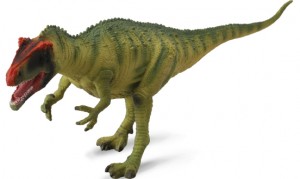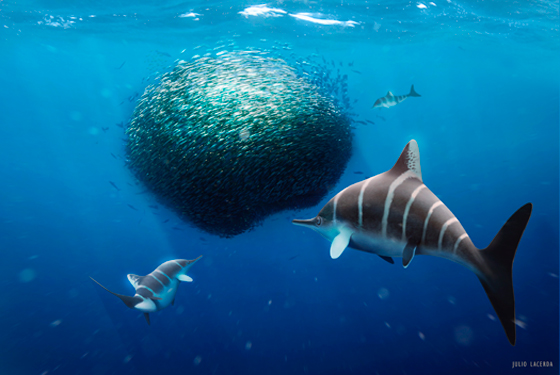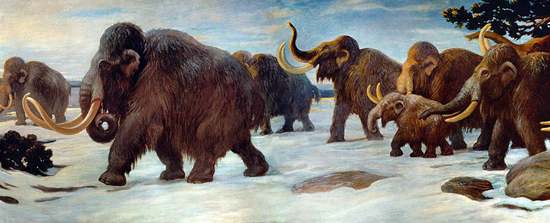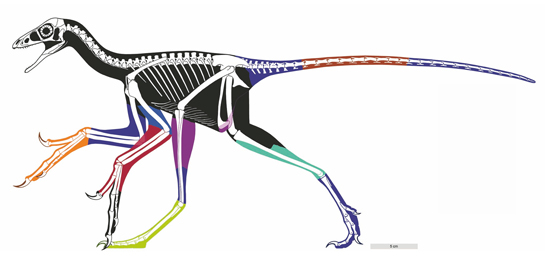CollectA Mapusaurus Dinosaur Model
Originally thought to be a new discovery of G. carolini fossil remains, Mapusaurus (M. roseae) has struggled to get out from under the shadow of its larger, theropod cousin, however, a Mapusaurus model has been added to the CollectA model range and this large carcharodontosaurid can take its place alongside other meat-eater replicas. A CollectA Mapusaurus has been added to the Prehistoric Life model range.
Mapusaurus
Members of a joint Argentinian/Canadian scientific expedition discovered the remains of a gigantic meat-eating dinosaur in exposed rocks forming part of the Huincul Formation of central Argentina in 1997. Subsequent excavations over the next four years uncovered the remains of at least seven theropod dinosaurs, representing fully grown individuals as well as immature specimens. The excitement over the discovery and naming of the giant, carnivorous dinosaur Giganotosaurus which had been found in the same part of Argentina just a few years before, had hardly died down when these new fossils were found. Initially, thought to be fossils of Giganotosaurus, a rigorous and thorough analysis of the skull material confirmed that this was a new meat-eating dinosaur discovery. Mapusaurus roseae was formally named and described by Rodolfo Coria and Phil Currie in 2006.
CollectA Mapusaurus
It is very exciting to see such a recently named and described dinosaur being featured in a model range. However, given the extensive fossil material ascribed to this species, much more than most large theropods it is no surprise. Mapusaurus was certainly an impressive animal, perhaps getting on for forty feet in length and weighing in at a hefty five/six tonnes, this dinosaur was an apex predator capable of bringing down the largest prey – even the mighty Argentinosaurus if enough of these meat-eaters attacked the same animal.
A Picture of the New CollectA Mapusaurus Model (CollectA Dinosaurs)
The long, narrow snout of Mapusaurus (pronounced “mah-pus-sore-us”), distinguishes this meat-eating dinosaur from other super predators such as the later abelisaurids and tyrannosaurs.
Model Measurements
Measuring an impressive twenty-five centimetres in length and with a head held seven centimetres off the ground, this is one of the larger not-to-scale models currently offered by CollectA. The model is painted a light green with darker stripes running from the backbone down the flanks and the hind limbs. There is a splash of contrasting red on the snout and highlighting the two small crests that are placed directly over the eyes. This dinosaur is posed with its mouth open and the small, fine teeth have been painted in well. This model has been given a thick, muscular neck, not the typical “S” shaped neck of an allosaurid model. This feature when combined with the thick and heavy tail, tends to make the model look rather stiff.
The short arms are well depicted and collectors will be pleased to see that the three-fingered hands with their claws have been skilfully moulded by the design team. Running along the spine there is a small, spiky crest that helps to give this dinosaur model a fearsome appearance.
Model collectors and dinosaur fans will appreciate the work that has gone into creating this replica. Perhaps a Carcharodontosaurus is on the cards for next year. Would you want a Carcharodontosaurus replica?
To view Everything Dinosaur’s dinosaur models currently in stock, including the CollectA model range: CollectA Prehistoric Life Models – Age of Dinosaurs.







I really like this modal but i dont know if this a defalt on my mapusaurus but the legs are really small. This pictures shows them being much biggers .It looks kinda stupid but is this just the modal or is it a defalt?
The hind legs on the Mapusaurus models are all the same, this dinosaur is known from a number of individual specimens, some of which were juveniles but at least two of the skeletons discovered to date represent very large and possibly fully grown animals. Ironically, it is the femur bones that have been found that have enabled scientists to estimate the size of the largest specimens. The thick tail, deep chest and thick neck make this dinosaur look a little top heavy but the model has been based on a detailed reconstruction of the actual fossil material. It has been estimated that some of the smaller individuals could have run at speeds of around 30 mph, making them, twice as fast as T. rex, although it must be pointed out that fully grown Mapusaurus specimens could likely not run as quickly.
Hello. You can see my Mapusaurus in my blog: http://ceratosaurus.blogspot.com.br/2011/06/ceratosaurus-vs-allosaurus.html
Regards.
Nice pics.